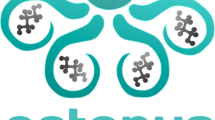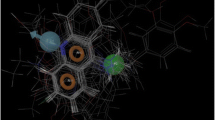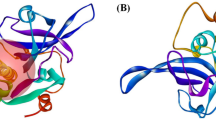Abstract
Malaria is the world’s most widespread protozoan infection, being responsible for more than 445,000 annual deaths. Among the malaria parasites, Plasmodium falciparum is the most prevalent and lethal. In this context, the search for new antimalarial drugs is urgently needed. P. falciparum superoxide dismutase (PfSOD) is an important enzyme involved in the defense mechanism against oxidative stress. The goal of this study was to identify through hierarchical screening on pharmacophore models and molecular dynamics (MD), promising allosteric PfSOD inhibitors that do not show structural requirements for human inhibition. MD simulations of 1000 ps were performed on PfSOD using GROMACS 5.1.2. For this, the AMBER99SB-ILDN force field was adapted to describe the metal-containing system. The simulations indicated stability in the developed system. Therefore, a covariance matrix was generated, in which it was possible to identify residues with correlated and anticorrelated movements with the active site. These results were associated with the results found in the predictor of allosteric sites, AlloSitePro, which affirmed the ability of these residues to delimit an allosteric site. Then, after successive filtering of the Sigma-Aldrich® compounds database for HsSOD1 and PfSOD pharmacophores, 152 compounds were selected, also obeying Lipinski’s rule of 5. Further filtering of those compounds based on molecular docking results, toxicity essays, availability, and price filtering led to the selection of a best compound, which was then submitted to MD simulations of 20,000 ps on the allosteric site. The study concludes that the ZINC00626080 compound could be assayed against SODs.

Plasmodium falciparum superoxide dismutase
















Similar content being viewed by others
References
WHO HOW (2017) World Malaria Report 2017
Cowman AF, Healer J, Marapana D, Marsh K (2016) Malaria: biology and disease. Cell 167:610–624
Lasonder E, Green JL, Grainger M, Langsley G, Holder AA (2015) Extensive differential protein phosphorylation as intraerythrocytic Plasmodium falciparum schizonts develop into extracellular invasive merozoites. Proteomics 15:2716–2729
Leite FHA, Da Fonseca AL, Nunes RR, Comar Júnior M, Varotti FDP, Taranto AG (2013) Malária: Dos velhos fármacos aos novos alvos moleculares. Biochem Biotechnol Rep 2:59
Braga CB e, Martins AC, Cayotopa ADE, Klein WW, Schlosser AR, Silva AF da, Souza MN de, Andrade BWB, Filgueira-Júnior JA, Pinto W de J, da Silva-Nunes M (2015) Side effects of chloroquine and primaquine and symptom reduction in malaria endemic area (Mâncio Lima, Acre, Brazil). Interdiscip Perspect Infect Dis 2015:1–7
Antony HA, Parija SC (2016) Antimalarial drug resistance: an overview. Trop Parasitol 6:30–41
Spitzmüller A, Mestres J (2013) Prediction of the P. Falciparum target space relevant to malaria drug discovery. PLoS Comput Biol 9:e1003257
Guido RVC, Oliva G, Andricopulo AD (2012) Structure- and ligand-based drug design approaches for neglected tropical diseases. Pure Appl Chem 84:1857–1866
Sterling T, Irwin JJ (2015) ZINC 15 - ligand discovery for everyone. J Chem Inf Model 55:2324–2337
Walters WP, Stahl MT, Murcko MA (1998) Virtual screening—an overview. Drug Discov Today 3:160–178
Lavecchia A, Giovanni C (2013) Virtual screening strategies in drug discovery: a critical review. Curr Med Chem 20:2839–2860
Batool S, Ferdous S, M a K, Iftikhar H, Rashid S (2013) In silico screening for identification of novel aurora kinase inhibitors by molecular docking , dynamics simulations and ligand-based hypothesis approaches. Enzyme Eng 2:1–12
Shibi IG, Aswathy L, Jisha RS, Masand VH, Gajbhiye JM (2016) Virtual screening techniques to probe the antimalarial activity of some traditionally used phytochemicals. Comb Chem High Throughput Screen 19:572–591
Nunes RR, dos Santos Costa M, dos Reis Santos B, da Fonseca AL, Ferreira LS, Russo Chagas RC, da Silva AM, de Pilla Varotti F, Taranto AG (2016) Successful application of virtual screening and molecular dynamics simulations against antimalarial molecular targets. Mem Inst Oswaldo Cruz 111:721–730
Carillon J, Rouanet J-M, Cristol J-P, Brion R (2013) Superoxide dismutase administration, a potential therapy against oxidative stress related diseases: several routes of supplementation and proposal of an original mechanism of action. Pharm Res 30:2718–2728
van Schalkwyk DA, Saliba KJ, Biagini GA, Bray PG, Kirk K (2013) Loss of pH control in Plasmodium falciparum parasites subjected to oxidative stress. PLoS One 8:e58933
Cacciapuoti F (2016) Oxidative stress as “mother” of many human diseases at strong clinical impact. J Cardiovasc Med Cardiol 3:001–006
Banci L, Bertini I, Cantini F, Kozyreva T, Massagni C, Palumaa P, Rubino JT, Zovo K (2012) Human superoxide dismutase 1 (hSOD1) maturation through interaction with human copper chaperone for SOD1 (hCCS). Proc Natl Acad Sci 109:13555–13560
Yuan Y, Pei J, Lai L (2013) Binding site detection and druggability prediction of protein targets for structure-based drug design. Curr Pharm Des 19:2326–2333
Feng Z, Hu G, Ma S, Xie X-Q (2015) Computational advances for the development of allosteric modulators and bitopic ligands in G protein-coupled receptors. AAPS J 17:1080–1095
Lee C-H, Huang H-C, Juan H-F (2011) Reviewing ligand-based rational drug design: the search for an ATP synthase inhibitor. Int J Mol Sci 12:5304–5318
Van Der Spoel D, Lindahl E, Hess B, Groenhof G, Mark AE, Berendsen HJC (2005) GROMACS: fast, flexible, and free. J Comput Chem 26:1701–1718
Soulère L, Delplace P, Davioud-Charvet E, Py S, Sergheraert C, Périé J, Ricard I, Hoffmann P, Dive D (2003) Screening of Plasmodium falciparum iron superoxide dismutase inhibitors and accuracy of the SOD-assays. Bioorg Med Chem 11:4941–4944
Berendsen HJC, Grigera JR, Straatsma TP (1987) The missing term in effective pair potentials. J Phys Chem 91:6269–6271
Hess B, Bekker H, Berendsen HJC, Fraaije JGEM (1997) LINCS: a linear constraint solver for molecular simulations. Chem 18:1463–1472
Darden T, York D, Pedersen L (1993) Particle mesh Ewald: an N · log(N) method for Ewald sums in large systems. J Chem Phys 98:10089–10092
Daura X, van Gunsteren WF, Mark AE (1999) Folding-unfolding thermodynamics of a beta-heptapeptide from equilibrium simulations. Proteins Struct Funct Genet 34:269–280
Huang W, Lu S, Huang Z, Liu X, Mou L, Luo Y, Zhao Y, Liu Y, Chen Z, Hou T, Zhang J (2013) Allosite: a method for predicting allosteric sites. Bioinformatics 29:2357–2359
Dong X, Zhang Z, Zhao J, Lei J, Chen Y, Li X, Chen H, Tian J, Zhang D, Liu C, Liu C (2016) The rational design of specific SOD1 inhibitors via copper coordination and their application in ROS signaling research. Chem Sci 00:1–12
Chemaxon (2013) MarvinSketch. https://chemaxon.com/products/marvin. Accessed 3 Jan 2015.
Tripos Inc. (2012) SYBYL-X: discovery software for computational chemistry and molecular modelling. Tripos Inc, Saint Louis
Mysinger MM, Carchia M, Irwin JJ, Shoichet BK (2012) Directory of useful decoys, enhanced (DUD-E): better ligands and decoys for better benchmarking. J Med Chem 55:6582–6594
Lipinski CA, Lombardo F, Dominy BW, Feeney PJ (2001) Experimental and computational approaches to estimate solubility and permeability in drug discovery and development. Adv Drug Deliv Rev 46:3–26
Irwin JJ, Sterling T, Mysinger MM, Bolstad ES, Coleman RG (2012) ZINC: a free tool to discover chemistry for biology. J Chem Inf Model 52:1757–1768
de Souza, BC (2017) Triagem virtual hierárquica para seleção de potenciais inibidores seletivos para a superóxido dismutase de P. falciparum. Universidade Estadual de Feira de Santana
Pettersen EF, Goddard TD, Huang CC, Couch GS, Greenblatt DM, Meng EC, Ferrin TE (2004) UCSF chimera - a visualization system for exploratory research and analysis. J Comput Chem 25:1605–1612
Trott O, Olson AJ (2009) AutoDock Vina: improving the speed and accuracy of docking with a new scoring function, efficient optimization, and multithreading. J Comput Chem 31:455–461
Allen WJ, Balius TE, Mukherjee S, Brozell SR, Moustakas DT, Lang PT, Case DA, Kuntz ID, Rizzo RC (2015) DOCK 6: impact of new features and current docking performance. J Comput Chem 36:1132–1156
Morris GM, Huey R, Lindstrom W, Sanner MF, Belew RK, Goodsell DS, Olson AJ (2009) AutoDock4 and AutoDockTools4: automated docking with selective receptor flexibility. J Comput Chem 30:2785–2791
Frishman D, Argos P (1995) Knowledge-based protein secondary structure assignment. Proteins Struct Funct Genet 23:566–579
Ferrin TE, Huang CC, Jarvis LE, Langridge R (1988) The MIDAS display system. J Mol Graph 6:13–27
Kuntz ID, Blaney JM, Oatley SJ, Langridge R, Ferrin TE (1982) A geometric approach to macromolecule-ligand interactions. J Mol Biol 161:269–288
Meng EC, Shoichet BK, Kuntz ID (1992) Automated docking with grid-based energy evaluation. J Comput Chem 13:505–524
Patlewicz G, Jeliazkova N, Safford RJ, Worth AP, Aleksiev B (2008) An evaluation of the implementation of the Cramer classification scheme in the Toxtree software. SAR QSAR Environ Res 19:495–524
Salentin S, Schreiber S, Haupt VJ, Adasme MF, Schroeder M (2015) PLIP: fully automated protein-ligand interaction profiler. Nucleic Acids Res 43:W443–W447
Malde AK, Zuo L, Breeze M, Stroet M, Poger D, Nair PC, Oostenbrink C, Mark AE (2011) An automated force field topology builder (ATB) and repository: version 1.0. J Chem Theory Comput 7:4026–4037
Lindorff-Larsen K, Piana S, Palmo K, Maragakis P, Klepeis JL, Dror RO, Shaw DE (2010) Improved side-chain torsion potentials for the Amber ff99SB protein force field. Proteins S8:1950–8
Schrödinger LLC (2016) PyMol: the PyMOL molecular graphics system, version 2.0. Schrödinger LLC., New York
Li P, Roberts BP, Chakravorty DK, Merz KM (2013) Rational Design of Particle Mesh Ewald Compatible Lennard-Jones Parameters for +2 metal cations in explicit solvent. J Chem Theory Comput 9:2733–2748
Verli H (2017) Bioinformática: da Biologia à Flexibilidade Moleculares
Branco RJF, Fernandes PA, Ramos MJ (2006) Molecular dynamics simulations of the enzyme cu, Zn superoxide dismutase. J Phys Chem B 110:16754–16762
Petrov D, Daura X, Zagrovic B (2016) Effect of oxidative damage on the stability and dimerization of superoxide dismutase 1. Biophys J 110:1499–1509
Lobanov MY, Bogatyreva NS, Galzitskaya OV (2008) Radius of gyration as an indicator of protein structure compactness. Mol Biol 42:623–628
Boucher IW, Brzozowski AM, Brannigan JA, Schnick C, Smith DJ, Kyes SA, Wilkinson AJ (2006) The crystal structure of superoxide dismutase from Plasmodium falciparum. BMC Struct Biol 6:1–10
Naithani A, Taylor P, Erman B, Walkinshaw MD (2015) A molecular dynamics study of allosteric transitions in Leishmania mexicana pyruvate kinase. Biophys J 109:1149–1156
Tommaso P, Di MS, Xenarios I, Orobitg M, Notredame C (2011) T-coffee : a web server for the multiple sequence alignment of protein and RNA sequences using structural information and homology extension. Nucleic Acids Res 39:13–17
Croft AM, Jacquerioz FA, Jones KL (2010) Human parasitic diseases drugs to prevent malaria in Travellers: a systematic review of randomized controlled trials. Hum Parasit Dis 2:1–19
Meslamani J, Li J, Sutter J, Stevens A, Bertrand H-O, Rognan D (2012) Protein–ligand-based pharmacophores: generation and utility assessment in computational ligand profiling. J Chem Inf Model 52:943–955
Poptodorov K, Luu T, Hoffmann RD (2006) Pharmacophore model generation software tools. In: Langer T, Hoffmann RD (eds) Pharmacophores and pharmacophore searches, 1st edn, pp 15–47
Caballero J (2010) 3D-QSAR (CoMFA and CoMSIA) and pharmacophore (GALAHAD) studies on the differential inhibition of aldose reductase by flavonoid compounds. J Mol Graph Model 29:363–371
Zhao X, Yuan M, Huang B, Ji H, Zhu L (2010) Ligand-based pharmacophore model of N-aryl and N-Heteroaryl piperazine α1A-adrenoceptors antagonists using GALAHAD. J Mol Graph Model 29:126–136
Brito CCB (2013) Avaliação e identificação de inibidores da enzima superóxido dismutase de tripanosomatídeos. Universidade Federal da Bahia
Sánchez-Moreno M, Gómez-Contreras F, Navarro P, Marín C, Ramírez-Macías I, Olmo F, Sanz AM, Campayo L, Cano C, Yunta MJR (2012) In vitro leishmanicidal activity of imidazole- or pyrazole-based benzo[g]phthalazine derivatives against Leishmania infantum and Leishmania braziliensis species. J Antimicrob Chemother 67:387–397
Braga RC, Andrade CH (2013) Assessing the performance of 3D pharmacophore models in virtual screening: how good are they? Curr Top Med Chem 13:1127–1138
Jain AN, Nicholls A (2008) Recommendations for evaluation of computational methods. J Comput Aided Mol Des 22:133–139
Empereur-mot C, Guillemain H, Latouche A, Zagury J-F, Viallon V, Montes M (2015) Predictiveness curves in virtual screening. J Cheminform 7:52
Hart PJ, Balbirnie MM, Ogihara NL, Nersissian AM, Weiss MS, Valentine JS, Eisenberg D (1999) A structure-based mechanism for copper−zinc superoxide dismutase. Biochemistry 38:2167–2178
Teixeira C, Vale N, Pérez B, Gomes A, Gomes JRB, Gomes P (2014) “Recycling” classical drugs for malaria. Chem Rev 114:11164–11220
Fracasso D, Fuentefria AM, Teixeira ML (2009) Avaliação toxicológica e quantificação de agentes antioxidantes em vinhos tintos comercializados no município de Concórdia. Revista Brasileira de Produtos Agroindustriais, 11:181–189
Acknowledgments
The authors would like to thank the Universidade Estadual de Feira de Santana for computational resources and Coordenação de Aperfeiçoamento de Pessoal de Nível Superior (CAPES) for financial support.
Author information
Authors and Affiliations
Corresponding author
Additional information
This paper belongs to Topical Collection XIX - Brazilian Symposium of Theoretical Chemistry (SBQT2017)
Electronic supplementary material
ESM 1
(DOCX 1.47 mb)
Rights and permissions
About this article
Cite this article
Araujo, J.S.C., de Souza, B.C., Costa Junior, D.B. et al. Identification of new promising Plasmodium falciparum superoxide dismutase allosteric inhibitors through hierarchical pharmacophore-based virtual screening and molecular dynamics. J Mol Model 24, 220 (2018). https://doi.org/10.1007/s00894-018-3746-0
Received:
Accepted:
Published:
DOI: https://doi.org/10.1007/s00894-018-3746-0




